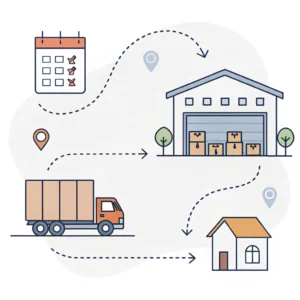EXW is preferred in industrial shipping because it places minimal responsibilities on the seller, enables buyers to shop for the most competitive logistics options, and offers better cost control and flexibility for managing overall supply chain risks.
In today's global industrial shipping landscape, selecting the appropriate Incoterm1 can be the difference between smooth operations and unexpected delays. The EXW trade term2 — referring to Ex Works — has emerged as a significant option for many industrial stakeholders. Under EXW, the seller is only responsible for making the goods available at their premises. This shifts much of the logistical challenges, transportation costs, and risks to the buyer. At first glance, this might appear as a disadvantage to buyers; however, in many industrial scenarios, many procurement managers find several advantages in selecting EXW, such as enhanced control over the supply chain, lower operational burdens on the seller, and opportunities to leverage better local logistics services.
Industrial shipping typically involves large volumes of goods, high-value shipments, and an environment where cost control is critical. When adopting EXW, both sellers and buyers must have a clear, predefined strategy to manage risks and optimize costs.
Under the EXW trade term, the seller's responsibility stops at making the product available at a designated location. This means no obligation to load, clear customs, or deliver to a final destination. For sellers, especially those in industrial manufacturing, this translates into reduced administrative overhead and less risk of unexpected liabilities during transportation.
For buyers, EXW opens up the opportunity to choose logistics providers that best fit their particular cost and service requirements. By engaging directly with multiple carriers, buyers can:
- Shop around for competitive shipping rates.
- Better manage consolidation of shipments.
- Schedule pick-ups in line with production and distribution demands.
This added flexibility is especially beneficial in the industrial sector where freight volumes are high, and transportation needs are both dynamic and tightly integrated with production schedules.
Industrial buyers can benefit from greater control over:
- Freight cost management: By negotiating directly with logistics companies, buyers can secure lower rates, optimize routing, and decide on multimodal shipping3 options.
- Risk allocation: EXW transfers almost all risk from the seller to the buyer. While this requires the buyer to be more proactive, it also streamlines the chain of responsibility and ensures that risks are managed by the party most capable of acting quickly on them.
A key advantage of the EXW term is its potential for savings:
- Cost Savings: With no mandatory handling by the seller, the buyer can select from a broader pool of carriers, potentially reducing shipping costs significantly.
- Operational Control: The buyer controls the loading, shipping, and final delivery steps. This is particularly crucial when dealing with specialized industrial products that require careful handling or route-specific considerations.
Flexibility is paramount in industrial freight. Buyers often deal with:
- Multiple Suppliers: Consolidating shipments from various suppliers becomes easier if each shipment adheres to a standardized trade term.
- Tailored Shipping Strategies: Buyers can select carriers based on specific requirements such as transit time, reliability, and cost efficiency.
To further illustrate the differences, let’s compare EXW with FCA (Free Carrier)4, another popular trade term:
| Feature | EXW | FCA |
|---|---|---|
| Seller Responsibility | Makes goods available at premises only | Loads goods onto a carrier at a pre-agreed location |
| Buyer Control | Maximized; buyer handles shipping and risks | Shared; seller handles loading to a point of carriage |
| Risk Management | Buyer assumes almost all shipping risks | Seller handles risk until goods are on board |
| Flexibility in Logistics | High; buyer negotiates directly with carriers | Less flexible; limited to seller’s chosen point for handover |
This table clearly shows that while EXW maximizes buyer flexibility, it also requires buyers to handle additional responsibilities in terms of shipping and risk management.
Consider a scenario where a manufacturer of heavy machinery in China sells products to a buyer in Europe. Using EXW, the logistics strategy unfolds as follows:
- The machinery is delivered to the manufacturer’s waterfront facility.
- The European buyer then arranges for container pick-up, custom clearance5, and final inland transportation.
- By choosing this method, the buyer can directly contract with several logistics providers, ensuring each leg of the journey is optimized for cost and transit time.
The advantages in this case include:
- Improved Cost Structure: Lower shipping costs due to competitive bids.
- Better Customization: Ability to coordinate schedules and handling processes that are specifically tailored to heavy industrial equipment.
- Enhanced Risk Mitigation: With responsibility clearly delineated, the buyer prepares by engaging reputable freight forwarders and warehousing solutions.
For industrial sectors, efficiency is not only about speed but also about precision:
- Inventory Management: Having control over the logistics process under EXW allows buyers to streamline their inventory through just-in-time delivery models.
- Regulatory Compliance: Buyers can work closely with their logistics partners to ensure that all regulatory and customs requirements are met efficiently without relying on the supplier.
While EXW offers several benefits, it is crucial to understand its limitations and potential risks:
- Increased Buyer Responsibility: The buyer must handle all transportation arrangements, customs documentation, and risk management from the seller’s premises onward.
- Logistics Complexity: For buyers inexperienced with complex shipping logistics, the lack of seller involvement can result in increased administrative burdens and potential delays.
- Not Suitable in All Scenarios: If the buyer is not equipped to manage these risks, alternative Incoterms such as FCA (Free Carrier) might be more appropriate.
- Documentation and Communication: Ensuring all parties understand the scope of responsibilities is vital to prevent disputes or miscommunications during shipping.
It is important that buyers prepare comprehensive contingency plans and always verify that their logistics partners are capable of handling large-scale industrial shipments under the EXW framework.
Use EXW when:
- The buyer has a well-established network of reliable logistics providers.
- There is substantial expertise in managing complex freight arrangements and international shipping regulations.
- The buyer desires complete control over transportation and cost management.
Adopting the EXW term effectively involves several key steps:
- Logistics Partner Evaluation: Carefully evaluate freight forwarders and carriers for reliability, cost, and regional expertise.
- Risk Assessment: Conduct a thorough analysis of potential risks involved in picking up and shipping goods from the seller’s location.
- Contractual Clarity: Ensure that contracts clearly define responsibilities, deadlines, and procedures in case of delays or disputes.
- Regular Audits: Implement routine checks and process audits to ensure that the logistics chain remains efficient and compliant.
- Technology Integration: Leverage supply chain management software to track shipments, maintain inventory levels, and coordinate multi-modal transport.
Below is a practical checklist that procurement managers can use when considering EXW for industrial shipping:
| Checklist Item | Action Required |
|---|---|
| Logistics Provider Evaluation | Compare quotes and service levels from multiple providers. |
| Risk Management Strategy | Develop a clear plan for handling unanticipated delays or losses. |
| Comprehensive Documentation | Ensure all necessary export, customs, and transit documents are prepared. |
| Contract Review | Have legal counsel review Incoterm clauses and related contracts. |
| Regular Supply Chain Audits | Schedule periodic assessments of logistics performance. |
This checklist helps ensure that both risk and cost are managed effectively, as well as building a resilient supply chain for industrial shipping projects.
To sum up, the EXW trade term can be a powerful tool for industrial shipping when used appropriately. It minimizes seller obligations, providing buyers with the flexibility to meticulously craft their logistics strategy. This tailored approach not only reduces overall shipping costs but also grants buyers enhanced control over risk management and operational scheduling.
However, EXW is not a one-size-fits-all solution. Its successful adoption depends on the buyer’s capacity to handle additional logistics responsibilities and the effectiveness of partnerships with credible freight forwarders. For those with in-depth knowledge and robust logistical frameworks, EXW can be strategically advantageous and cost-effective.
Procurement professionals in the industrial sector should evaluate their internal logistics capabilities, partner competencies, and overall strategic objectives before transitioning to EXW. A well-prepared procurement strategy that includes clear responsibilities, risk management protocols, and contractual safeguard can harness EXW’s full potential, leading to a more competitive and efficient supply chain.
By taking these steps, companies can not only streamline their industrial shipping processes but also better navigate the complexities of international freight forwarding—a critical element in today’s global marketplace.
What are the advantages and disadvantages of EXW?
Under EXW terms, sellers are only required to provide goods at their premises. The buyer is responsible for transportation costs and assumes the shipping risks. This arrangement is advantageous for sellers with minimal obligations, but it places more operational responsibility and risk on the buyer.
Can a shipper benefit more from EXW?
Yes, shippers can benefit from EXW as it allows them to negotiate directly with multiple logistics providers. This can lead to cost savings and customized shipping strategies, provided the shipper is prepared to manage the associated risks and responsibilities effectively.
When should EXW not be used?
EXW might not suit buyers who lack the necessary expertise or resources to handle shipping, loading, and customs clearance. In these cases, alternatives like FCA, where the seller shoulders the responsibility for loading and risk until the goods are handed over, should be considered.
-
Incoterm: Reading the article will help you understand standardized international commercial terms that define the responsibilities of buyers and sellers in global trade. ↩
-
EXW trade term: Reading the article will clarify the specifics of the Ex Works term, outlining the minimal obligations of the seller and the increased responsibilities for the buyer. ↩
-
Multimodal shipping: Reading the article will explain the concept of using various transportation modes in a single shipment to optimize cost and transit efficiency. ↩
-
FCA (Free Carrier): Reading the article will provide insights into how the Free Carrier term differs from other Incoterms, particularly regarding risk allocation and logistics responsibilities. ↩
-
Custom clearance: Reading the article will help you understand the processes and documentation required to adhere to customs regulations during international shipping. ↩












